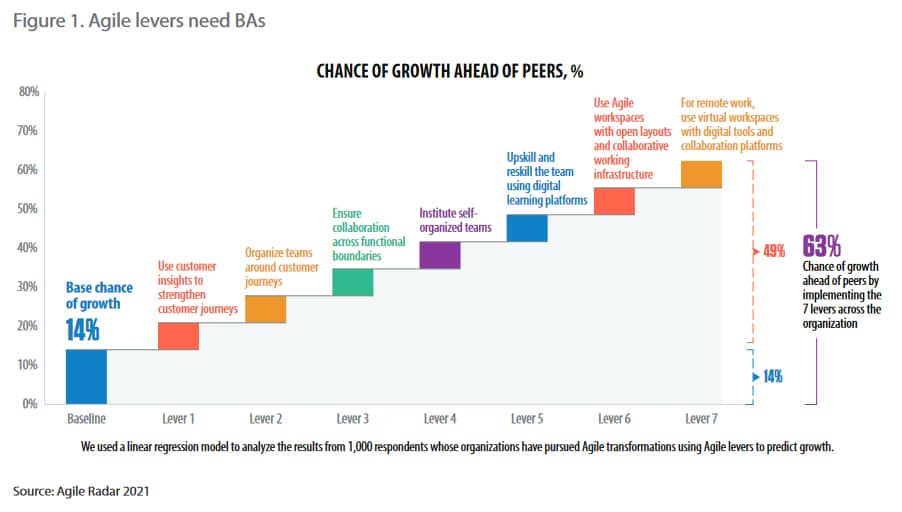Insights
- BAs bridge the gap between IT delivery and the business with strong customer-facing and in-depth analytical skills. They have unique capabilities to turn conversations and insights into detailed technical requirements that coders understand.
- But the Agile framework has neutralized the traditional BA role. With the focus on iterative software delivery, BAs are no longer required to do hard, risk-based analysis.
- BAs can take on the role of proxy POs. They can do all the things that POs are not able to do due to time and geographical constraints — nurturing product teams, informing POs when decisions aren’t based on sound data, prioritizing and grooming product backlogs, translating technical jargon into business needs, and redefining the product road map after successive Agile iterations.
- Proxy POs can then evolve into a full PO before moving further up the value chain to take on product management roles.
- Just like POs, BAs should be groomed to increase their investigative, logical, empathic, and facilitation skills, with a bias toward human-centric product development. They will be torchbearers for their team members, showing which products can help achieve maximum business impact.
BAs bridge the gap between IT delivery and the business with strong customer-facing and in-depth analytical skills. They have unique capabilities to turn conversations and insights into detailed technical requirements that coders understand. From Amazon to Boeing and from hotels to Silicon Valley startups — all rely on BAs to wring out maximum profits and stay competitive. They are “PhDs with personality,” as one Harvard Business Review article puts it.1
But there is a problem.
The Agile framework has neutralized the traditional BA role. With the focus on iterative software delivery, BAs are no longer required to do hard, risk-based analysis. Agile focuses on experimentation, lightning-fast market analysis, and delivering business value in short, sharp sprints. The PO, the technical architect, and the security engineer are at the forefront here, while the role of BA is limited to waterfall methods.
This needs to change.
BAs have exquisite verbal and nonverbal intelligence, creative thinking, technological proficiency, and responsiveness. They can enable product teams — the heartbeat of the 2022 Agile methodology — to collaborate more effectively, acting as business mentors and coaches. BAs can add significant value by working closely with product stakeholders and data analysts, turning insights into actions. And they possess the capability to deliver agile digital transformation at enterprise and business levels.
BAs can enable product teams to collaborate more effectively, acting as both mentors and coaches
BAs as exceptional Agile practitioners
As important as data and business storytelling are to the enterprise, how can BAs become fundamental to Agile teams?
BAs can take on the role of proxy POs. They can do all the things that POs are not able to do due to time and geographical constraints — nurturing product teams, informing POs when decisions aren’t based on sound data, prioritizing and grooming product backlogs, translating technical jargon into business needs, and redefining the product road map after successive Agile iterations. They should keep business objectives firmly in mind while performing these activities. Proxy POs can then evolve into a full PO before moving further up the value chain to take on product management roles.
Agile levers as a proxy PO
It is crucial to thoroughly map the roles of a PO and a proxy PO and not consider them interchangeable. A proxy PO can enable the organization to explore solutions that the PO cannot implement due to time limitations.
BAs as proxy POs need to pursue the following Agile behaviors:
Objectives and key results: BAs can be at the vanguard of defining and achieving business outcomes. They can translate business objectives into product key performance indicators (KPIs) and then help the business organize teams around the highest-value customer journeys.
Customer insights: BAs as proxy POs are closest to customers. Through in-depth conversations with relevant stakeholders and tools like A/B testing and analytics software, BAs can prepare insights on failing customer journeys by analyzing where customers are dropping off, how churn can be reduced, and how traction can increase. These insights are shared with POs to refine product vision and road map, creating momentum.
Iterative funding: BAs can communicate product features and business value with their strong intuitive sense. In Agile, they should be involved in defining the product vision at the start of each sprint and redefining it in each successive product release. They can help the PO advocate for more money at every stage in the road map, onboarding key executives by demonstrating business value through dashboards and easy-to-digest data insights.
Product-based value delivery: Agile product teams organize themselves around high-impact value streams. There is a bias toward organizing products into product lines and translating business objectives into product KPIs such as revenue, cash flow, and cost. BAs can help Agile teams effectively sequence and prioritize work. They can also use advanced negotiation skills with vendors, partners, and customers to ensure the best product is built. Also, when other team members are working on sprint requirements, BAs can act as product accelerators by informing customers when certain product features aren’t possible at certain stages.
Continuous market/industry analysis: Agile teams are like startups within the broader business. They move quickly, break things, and make things work better. However, without in-depth market and industry analysis, product teams may not be able to build accurate products and may launch them before the market is ready. BAs stay aware of the latest market updates and competitor activities. At Apple, Agile BAs are expected to show three definitive characteristics: deep domain and market expertise, allowing them to meaningfully engage; immersion in industry details; and the ability to collaboratively debate with key business officials through expert storytelling skills.
Experimentation in quick feedback loops: At Airbnb, BAs work with development and user interface teams to design prototypes and mock-ups for rapid feedback. This allows the firm to experiment with new ideas. BAs are proxy POs and part of autonomous, high-performing pods that can change features in the product backlog and discontinue initiatives altogether. POs and business sponsors can then quickly define new strategies that unlock funding from the executive suite.
Self-organized, autonomous, and persistent teams: Agile BAs steer product vision and are the voice of the business in IT programs. They ensure that continuous innovation becomes the mantra and that teams are invested in growth. With so much domain knowledge and a deep understanding of every stakeholder, they help product teams provide solutions before users even realize they need them, often leading to breakthrough innovations.
At Airbnb, BAs are proxy POs and part of autonomous, high-performing pods that can change features and discontinue initiatives altogether
Upskilling: BAs can act as business advisors and Agile team coaches. They keep the team updated on new technologies, translate technical language into easy-to-digest business speak (and vice versa), and employ tactics such as in-depth research, journal writing, and workshops for increased team effectiveness. They also ensure information radiators are updated daily for increased team visibility and productivity.
Remote Agile setting: BAs can bridge gaps between remote teams, bringing them closer to achieving better business outcomes. They should learn to set team expectations early in the sprint cycle, using information radiators where possible. BAs should ensure interactions are collaborative and productive; shorthand note taking and active listening can be helpful.
ALM tools: Once BAs master the Agile application lifecycle management (ALM) tools, they can transform into full POs. On this journey, BAs are involved in product planning, design and prototyping, and testing and integration. This enhances their skill set and enables them to effectively mentor team members. This way, the team practices holistic Agile.
BAs at the vanguard of business growth and cultural change
BAs have all the makings to become vital for Agile teams. According to Agile Radar 2021 research, BAs can effectively contribute across all seven Agile levers targeting business growth (see Figure 1).2

Another insight from the research was that though Agile cultural pain points like business-IT misalignment are most pressing for executives this year, only a few leaders are investing to address this. A good BA will power cultural transformation, moving the enterprise from “doing” to “being” Agile. Perhaps BAs can enjoy increased status as cultural warriors, much like data analysts and data scientists. These collaborative and effective individuals can use teamwork skills to speed up proof of concepts and provide unique perspectives on demo releases, feature backlogs, design thinking, and even exponential technologies such as cloud, AI, no code/low code , and immersive experiences in the Metaverse.
Just like POs, BAs should be groomed to increase their investigative, logical, empathic, and facilitation skills, with a bias toward human-centric product development. They will be torchbearers for their team members, showing which products can help achieve maximum business impact. In doing so, BAs become the most focused, energetic, innovative, and prized members of the increasingly autonomous Agile product teams.
References
- Competing on analytics, Thomas H. Davenport, Jan. 2006, Harvard Business Review.
- Agile Radar 2021, IKI.





